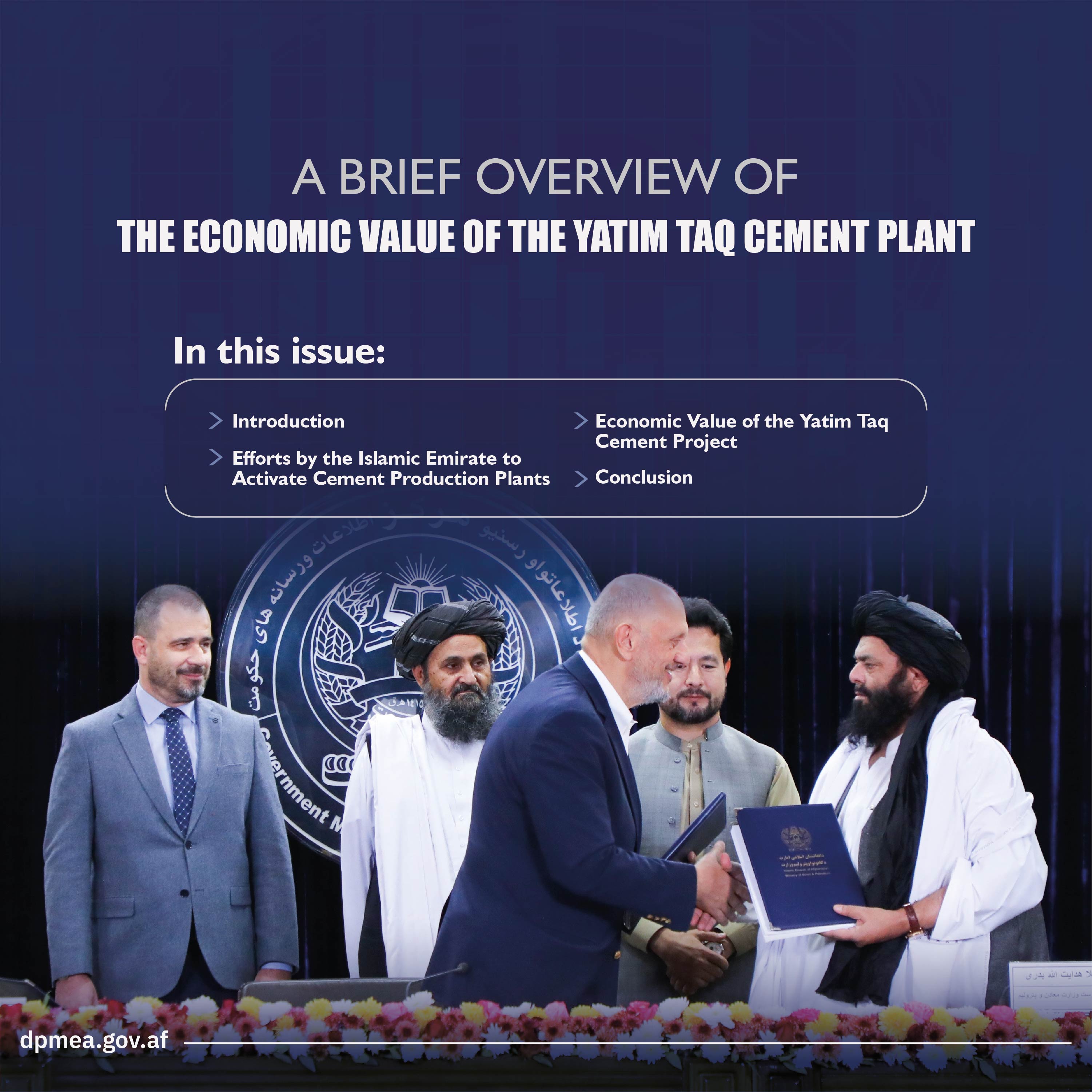A Brief Overview of the Economic Value of the Yatim Taq Cement Plant

Introduction
Cement is a critical material in the infrastructure development of countries, produced industrially from raw mineral materials using relatively simple technology. It is utilized in constructing bridges, culverts, industrial, service, civil, and military buildings, as well as in water and power dams and water supply networks. The availability of cement at reasonable prices within a country has a significant impact on the cost of constructing these structures and, ultimately, on the country’s overall economic growth.
In 2016, more than four billion tons of cement were produced globally. Of this, China alone produced 2.35 billion tons, India 290 million tons, the United States 85.9 million tons, Turkey 77 million tons, and the remainder by other countries. In that same year, Afghanistan’s neighboring countries, Iran and Pakistan, produced 53 million tons and 32 million tons of cement, respectively. Both of these countries not only meet their own cement needs but also have surplus for export, with Afghanistan being one of their key markets.
Afghanistan’s annual cement demand ranges between 5 to 7 million tons. If this amount of cement is imported from neighboring countries, hundreds of millions of dollars are paid to them each year for a commodity that could be produced locally, given the presence of essential mineral resources within Afghanistan. Recognizing the importance of cement and the availability of the necessary mineral resources for its production domestically, the Islamic Emirate is actively working toward self-sufficiency in this sector. For this purpose, efforts are underway to restore existing cement plants and establish new ones. The following is an account of the steps taken by the Islamic Emirate in this area.
Efforts by the Islamic Emirate to Activate Cement Production Plants
With the Islamic Emirate of Afghanistan regaining power, its primary focus has been to strengthen Afghanistan's economy through all feasible measures that can help achieve economic stability. One of these efforts is securing the required supply of cement for infrastructure rebuilding and construction across the country. Currently, Afghanistan produces only a limited amount of cement, with the remainder imported from neighboring countries, costing millions of dollars annually. The Islamic Emirate aims to boost domestic cement production to meet local demands and support construction needs internally.
To date, two major cement production plants in Afghanistan have been reactivated: the Ghori Cement Plant in Baghlan and the Jabal Saraj Cement Plant in Parwan. Meanwhile, work continues on constructing cement plants in Shurandam, Kandahar, and Herat. The Ghori Cement Plant now produces up to 600 tons of cement per day, and officials there are working to increase this output to 1,400 tons per day, which would meet 14% of the country’s demand.
Additionally, the Jabal Saraj Cement Plant in Parwan was reactivated after 20 years of inactivity. Damaged during years of conflict, this plant was restored at a cost of 70 million Afghanis and resumed operations. Currently, it produces 100 tons of cement every 24 hours. In 2023, a contract worth $220 million was signed with a Qatari and Afghan company for the Jabal Saraj Cement Plant, aiming to increase its annual production capacity to 1.5 million tons of cement.
Not stopping there, on October 29, 2024, a contract for the construction of the Yatim Taq Cement Plant in Jowzjan Province was signed between the Ministry of Mines and Petroleum and the Turkish 77 company, under the oversight of the Deputy Prime Minister for Economic Affairs, Mullah Abdul Ghani Baradar Akhund. This project involves an investment of approximately 11 billion Afghanis.
Through these plants, the Islamic Emirate aims to make Afghanistan self-sufficient in cement production. Cement is essential for construction and, when produced sufficiently, plays a critical role in the country’s economic growth.
Economic Value of the Yatim Taq Cement Project
In today’s era of science and technology, access to the most advanced technologies globally can be obtained for a price. Afghanistan's physical proximity to China—the world’s second-largest economy—provides an advantage. China alone produces nearly half of the world’s cement and has some of the largest cement production factories with various capacities. This proximity allows Afghanistan to utilize China’s technology at relatively affordable rates.
Considering domestic cement production opportunities, the Islamic Emirate has accelerated its efforts in this sector. Following the reactivation of the Ghori and Jabal Saraj cement plants, the government has started work on establishing cement production plants in Kandahar and Herat provinces. Most recently, a contract was signed with a Turkish company for constructing the Yatim Taq Cement Plant in Jowzjan Province. This plant, with an investment of approximately 11 billion Afghanis, will have a daily production capacity of 3,000 tons, which will significantly meet the country's cement demands and is a substantial step toward self-sufficiency in the cement sector.
Additionally, the project will positively impact the country’s economic growth. Upon completing these plants—two of which are already operational and producing cement—the millions of dollars currently spent on importing cement from neighboring countries will be saved. This initiative will create an environment conducive to both domestic and foreign investment, providing jobs for thousands of people across Afghanistan.
Conclusion
Cement production in Afghanistan is minimal, with the country not even appearing on global producers' lists and covering only a small percentage of its own consumption needs. Afghanistan’s annual cement demand ranges from 5 to 7 million tons, and if the Islamic Emirate plans to establish more infrastructure in the future, this demand will only increase further. Continuing to import cement from neighboring and regional countries would mean double the current expenditure on cement imports.
Recognizing the need for cement and its economic importance, the Islamic Emirate has initiated efforts toward self-sufficiency in this sector. So far, the government has signed contracts valued at approximately 43 billion Afghanis with both domestic and international companies in the cement sector, the latest of which is for constructing the Yatim Taq Cement Plant in Jowzjan. This will pave the way for increased investment, create thousands of jobs, and significantly advance Afghanistan's economy.